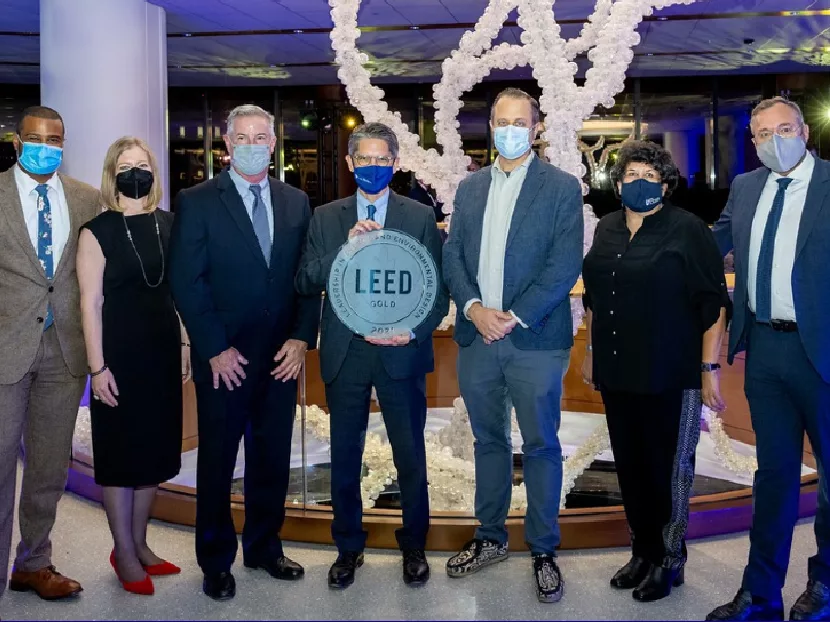Penn Medicine’s new Pavilion on the Hospital of the University of Pennsylvania’s campus has broken new ground for sustainable healthcare construction and design with Leadership in Energy and Environmental Design (LEED) Healthcare Gold Certification. Incorporating sustainability efforts since the beginning of its development, the 17-story, future-ready patient facility is the largest certified project in the world to achieve Gold certification or higher in LEED Healthcare. At 1.5 million square feet, the Pavilion — which will open Oct. 30 — is also the first hospital in the United States of more than 1 million square feet to achieve certification in LEED Healthcare.
“At Penn Medicine, implementing sustainability measures in our buildings has been a key area of our leadership in the health care field, to not only conserve energy but also improve the way patient care is delivered,” Kevin B. Mahoney, CEO of the University of Pennsylvania Health System, said. “Our workforce is deeply committed to climate stewardship, and in the Pavilion, they can be proud to be part of a new era in conservation that puts medicine on the map as a force for improving the health of our planet.”
LEED, developed by the U.S. Green Building Council (USGBC), is the most widely used green building rating system in the world and an international symbol of excellence. The LEED Healthcare rating system focuses on green initiatives at inpatient, outpatient and licensed long-term care facilities, medical offices, assisted living facilities, and medical education and research centers. To become LEED certified, a building must earn a threshold of points across multiple measurements for green building excellence, from sustainable site development to energy efficiency and water savings.
Conservation initiatives during the Pavilion project included recycling materials that were collected after the demolition of Penn Tower, which formerly stood on the new hospital’s site, including 291 tons of scrap steel and 17,000 tons of concrete. In addition, during the Pavilion’s construction, about 25 percent of materials were prefabricated and manufactured off-site, including more than 570 mechanical/electrical/plumbing racks and all 504 bathrooms for each patient room. This process minimized on-site waste, reduced traffic impact and site congestion, increased quality, and lowered cost.
Overall, the energy efficiency efforts in the Pavilion are anticipated to save more than 14 percent in annual energy costs compared to merely a code-compliant hospital. The building itself also uses 100 percent outside air through its HVAC system, using energy recovery wheels to capture and repurpose waste energy.
Along with saving energy, the facility was constructed to cut 30 percent of typical indoor water use through the installation of select fixtures and designs that use significantly less water, such as low-flow and low-flush toilets, sinks, and showers. In addition, more than 20 percent of the water required for the building’s HVAC equipment is provided by water captured and reused on site, such as rainwater, condensate, and foundation dewatering. Two cisterns, to help supply the chilled water system, are projected to process 7 million gallons of captured non-potable water each year.
The Pavilion’s property also includes an acre of greenery through landscaping surrounding the facility — including ground-level greenery that helps “bring the outside in” to patients and employees through abundant windows — and green roofs. Landscaped areas will feature native and hardy species that require minimal watering and maintenance.
The facility’s eco-friendly finishes extend to enabling green transit options for the thousands who will work and visit the Pavilion each day. In the 690-space underground parking garage, 2 percent of parking spaces have access to electric vehicle recharging stations, and to promote cycling and walking, 352 new bicycle parking spots have been installed at various locations surrounding the Pavilion. A new pedestrian pathway connecting the facility to Penn Medicine Station makes for easily accessible train travel for staff and visitors who use public transportation.
Design and planning for the Pavilion was orchestrated by PennFIRST, an integrated project delivery (IPD) team comprised of Penn Medicine employees, health care design firm HDR, architects Foster + Partners, engineering firm BR+A, and construction managers L.F. Driscoll and Balfour Beatty.
“An integral part of Penn’s campus development plan is to mindfully consider how our projects respond to our sustainability goals. In earning a LEED Gold designation, the Penn Medicine Pavilion exceeds this important consideration while adding to the transformation of our spectacular urban campus,” said Anne Papageorge, vice president for facilities and real estate services at the University of Pennsylvania.
Every new building and major renovation project currently under design at Penn is registered with the USGBC and is targeting LEED Silver rating or higher. The Pavilion is one of nearly 40 Penn buildings to achieve LEED certification, including Penn Medicine’s Valley Forge location, Penn Medicine Radnor, the Perelman Center for Advanced Medicine, and Penn Medicine’s University City Office Tower.




